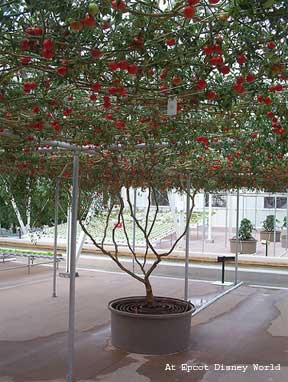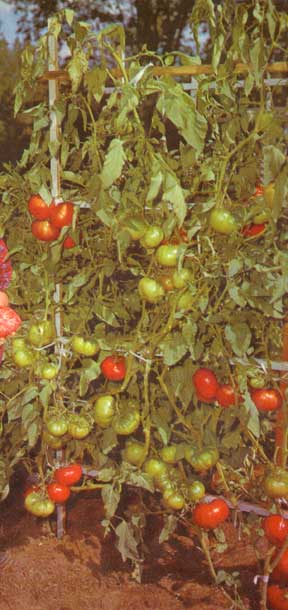If you have never grown climbing tomatoes in your garden, you certainly have missed an opportunity to grow one of the largest and best tasting tomatoes known. There are hybrids, of course, that may grow about as large, and look as good, but none have the delicious flavor and meaty goodness of climbing tomatoes.
Many of the fruits grown on these six-foot vines weigh over a pound at maturity. and are so round that just one circle completely covers a slice of ordinary bread.
All Meat
One wonderful thing about these luscious tomatoes is that they are practically all meat. The seed pockets are so narrow they are hardly noticed. Nothing gave me more pleasure last season than walking into the garden, taking one of these beauties off the vine, and enjoying it right then and there.

Another outstanding point about climbing tomatoes is that they bear as though the very life of the family depended upon them. There are clusters upon clusters of huge fruits even though all suckers and side shoots are removed. One vine easily brings forth a bushel of delicious red tomatoes. A dozen vines will produce ample tomatoes for a family of four. This includes tomatoes for table use, for juice, canning, sauces, eating right off the vine, and giving to friends and neighbors.
The only drawback in growing these tomatoes is that they must be staked. Most of these vines grow to a height of six feet or more. The weight of the fruit will cause them to break if not sufficiently supported. But the Final results are so rewarding that one will not mind the little time, work and patience it takes to stake and sucker these wonderful plants through the summer.
Grow Your Own Plants
This is not only sound advice, but a must, for it is almost impossible to buy plants commercially for transplanting in your garden. Unfortunately, the demand is not great enough to warrant a steady market for plant growers. However, these plants are so robust (just about every seed sprouting) that it is quite simple to grow your own plants. Purchase seeds at the local store or get them through a mail order seed catalog. Most of them do have seeds of the climbing tomato. Sometimes the plants are listed as “trellis tomatoes.” Be sure to purchase seeds of the variety that produces large fruit.
Plant seeds in light, friable soil, medium in fertility, at least six to eight weeks before transplanting time. Plant in a small seed flat, and place in a sunny window, or use a cold frame out of doors. Cover seeds with one-fourth inch of fine soil, and firm gently with a board. Water with a spray, and keep moderately moist until sprouting occurs. Temperatures best for germination are between 65 and 70 degrees.
When plants are two inches tall, transplant them to seed flats, or to another section of the cold frame, to stand an inch apart each way. Shade plants until they catch on, and at no time allow the bed or box to dry out. A liquid fertilizer may be used once or twice during the growth, but stay clear of overfertilizing. Too much food will cause the plants to shoot up tall and slim, rendering them unfit for garden use.
A week before transplanting to their final bed, begin hardening off the plants.This is done by exposing the tender plants to the direct rays of the sun a few minutes longer each day until they can take a full day’s sun without wilting. Hold back on water at this time to allow the plant cells to harden sufficiently.
Transplanting
A warm, sandy loam, rich in organic matter, is best for tomatoes, although they will do well in almost all soils. Since the size and flavor of these gigantic tomatoes depend entirely upon the fertility of the soil and the moisture content, it is wise to keep your soil at its height of fertility at all times, and to apply plenty of water throughout the growing season.
Before transplanting, cultivate the plot to a depth of 16 inches, turning in any organic matter you have on hand. Before raking smooth, broadcast a fertilizer high in phosphorus, but very low in nitrogen. Nitrogen tends to create thick branches and small fruit. If soil is acid, limestone or powdered lime may be added at this time. Rake the area smooth, mixing the fertilizer well with the soil.

Stretch a guide line, then dig holes for the plants 20 inches apart in rows 36 inches apart: Every bit of this room is needed, for these grow into monstrous vines.
Into each hole place a handful of dehydrated manure, and one teaspoon of superphosphate. Mix well with the soil. When, taking plants from the cold frame, do not disturb roots any more than necessary, and plant one inch deeper than they had been growing. Water immediately with water into which has been stirred a small amount of liquid plant food. If sun is hot the following day, provide shade until plants become adjusted.
You may drive in the stake now if you wish, but it is better to wait until after cultivation.
Summer Care
Scrape surface between rows with a hoe until plants have caught on and produced a little growth. Cultivate lightly to loosen the earth around each plant after rain, but do not dig too near the roots. When plants are 18 inches tall and have branched out nicely, hill them high as you would potatoes or corn. This added dirt will serve to keep the roots cool and moist through the season.
Apply a liberal amount of fertilizer around each plant and work it in well.
After applying the chosen fertilizer, mulch the entire area with at least six inches of grass clippings, rotted hay, straw, or other organic material that will serve the purpose. This mulch will discourage weeds and provide extra food for the plants every time it rains.
We usually drive in the stakes now. These stakes may be one single pole seven feet tall, or two poles joined by strong cross bars like the ones we use. Our method of staking saves time, serves a dual purpose by taking care of two plants at a time, and produces better and larger tomatoes because the vines are not crowded.
Set pole, or poles, five inches from a plant on the north side, and drive 18 inches into the ground.
As soon as the plants are 14 inches tall, it is time to start pruning. With sharp pruning shears, remove all side shoots and suckers. The remaining two or three vines are then tied to the pole or cross bar with “flagging tape” the kind you see at crime scenes.
Tying and pruning should be continued all summer. If weather is dry, water well once a week. An over-night soaking is best.
Harvesting
When fruit begins to ripen, the foliage may be cut away slightly to allow sunlight to fall on the tomatoes to hasten the process. The tops of the vines should also be cut back to encourage larger growth in the tomatoes. Pick when bright red for best flavor.
Anyone in Mid-America, where the growing season is long enough, can grow and enjoy climbing tomatoes if they will remember to grow their own plants, use a fertilizer high in phosphorus, cultivate well, prune and sucker, tie the vines to their posts as they grow longer, and provide water during dry spells. The first tirne you a bite into one of these luscious beauties, you will agree they were worth. the effort.
by B. Brinhart
